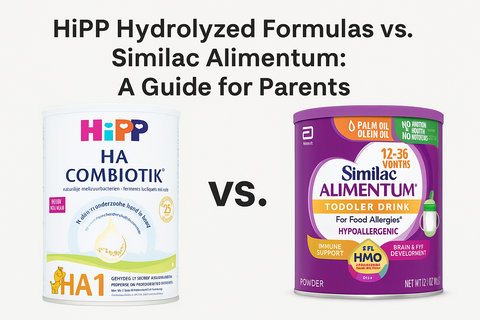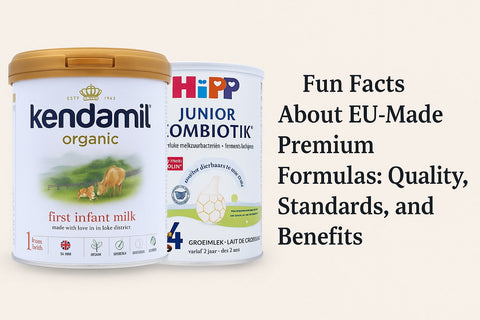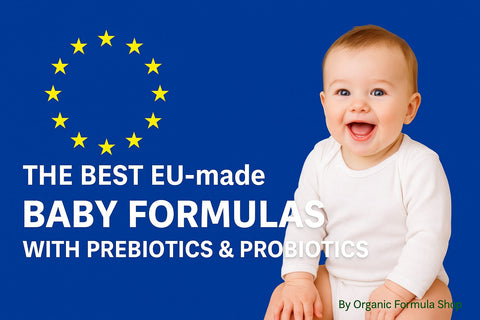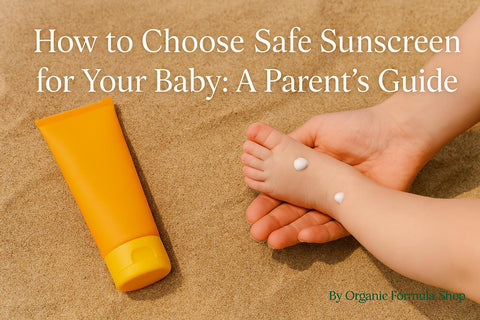Whey and Casein in EU Baby Formulas: Your Guide to Premium Nutrition
Choosing the right baby formula can feel like a high-stakes puzzle for any parent. With endless options lining store shelves and online carts, getting lost in the details is easy. If you’re a discerning, well-educated parent searching for premium, EU-made formulas, you’ve likely encountered terms like whey and casein. These are the proteins at the heart of most milk-based formulas. But what do these proteins do, why do their ratios matter, and how do European formulas stand head and shoulders above their US counterparts? In this in-depth guide, we’ll unravel the science of infant nutrition in a warm, approachable way, empowering you to make the best choice for your little one.
At Organic Formula Shop, we’re proud to bring you EU-made premium formulas that blend purity, quality, and cutting-edge nutrition. Sourced from Europe’s pristine farms, our formulas are designed to nurture happy, thriving babies. Let’s dive into the world of baby formula proteins and discover why EU standards set the gold standard for infant care.
The Vital Role of Protein in Your Baby’s Growth
Proteins are the unsung architects of your baby’s development, laying the foundation for everything from tiny fingers to a sharp mind. Whether you’re breastfeeding or formula-feeding, proteins deliver a suite of essential benefits:
- Physical Growth: They build muscles, bones, and organs, fueling your baby’s rapid transformation.
- Brain Development: Proteins produce neurotransmitters, the chemical messengers that spark cognitive leaps and emotional growth.
- Immune Strength: They craft antibodies, arming your little one against colds and infections.
- Energy and Satisfaction: Proteins keep hunger at bay, supporting healthy feeding rhythms.
- Nutrient Harmony: They form enzymes that help absorb vitamins and minerals, ensuring every bite counts.
In breast milk, the protein mix evolves. Starting with a whey-heavy profile (up to 80% in colostrum) and settling into a 60:40 whey-to-casein balance as it matures. EU-made formulas take cues from this natural progression, fine-tuning their protein blends to mirror breast milk’s brilliance. But what exactly are whey and casein, and how do they team up to support your baby?
Whey and Casein: The Dynamic Duo of Infant Nutrition
Most EU formulas, crafted from cow’s or goat’s milk, rely on whey and casein as their protein backbone. These complete proteins, packed with all nine essential amino acids, work in tandem to nourish your baby. Here’s a closer look at their unique roles.
Whey Protein: The Fast-Acting Powerhouse
Whey is the liquid gold of milk. Light, quick to digest, and brimming with amino acids like leucine (for muscle repair), lysine (for hormone production), and tryptophan (for mood regulation). It’s the dominant protein in early breast milk, making it a natural choice for newborns. Whey’s standout benefits include:
- Gentle on Tummies: It empties the stomach swiftly, reducing fussiness for sensitive infants.
- Growth Fuel: Whey drives muscle and tissue development during those early, fast-paced months.
- Antioxidant Shield: It bolsters defenses against oxidative stress, keeping cells healthy.
- Metabolic Magic: Its rapid absorption supports healthy weight and energy levels.
EU favorites like HiPP Dutch and Kendamil (KLOPT DIT MET KENDAMIL?) lean into whey’s digestibility, offering a breast milk-inspired option for delicate systems.
Casein Protein: The Slow-Release Sustainer
Casein, the slower partner in this duo, forms a thicker curd in the stomach, delivering a steady stream of nutrients. Rich in amino acids like methionine (for detoxification), histidine (for immunity), and threonine (for fat metabolism), casein shines with:
- Prolonged Fullness: It keeps babies satisfied longer, perfect for stretching time between feeds.
- Muscle Support: Casein aids long-term growth, complementing whey’s quick action.
- Heart Health: It helps regulate triglycerides, a win for cardiovascular wellness.
- Antioxidant Boost: Like whey, casein fights oxidative stress for overall vitality.
Formulas like Holle Bio harness casein’s sustaining power, providing balanced nutrition as your baby grows.
Whey vs. Casein: A Perfect Partnership
Think of whey and casein as a tag team: whey swoops in with fast nourishment, while casein sticks around for lasting support. Higher whey ratios are gentler on immature digestive systems, while balanced blends offer versatility. This synergy is a hallmark of EU formulas, designed with your baby’s comfort and development in mind.
The Whey-to-Casein Ratio: Precision Nutrition
One of the brilliance of EU-made formulas lies in their whey-to-casein ratios, carefully calibrated to echo breast milk’s natural shift from 80:20 (whey-dominant) to 60:40. Raw cow’s milk, by contrast, is casein-heavy (20:80), which is less ideal for infants. European manufacturers adjust these ratios to optimize digestibility and nutrition, tailoring them to your baby’s age and needs. To give you a clearer picture, here’s a breakdown of whey-to-casein ratios in some of the most popular EU formulas:
| Baby Formula | Whey-to-Casein Ratio |
|---|---|
| HiPP German Formula | 60:40 |
| HiPP UK Formula | 50:50 |
| HiPP Dutch Formula | 60:40 |
| Holle Bio Formula | 40:60 |
| Lebenswert Formula | 60:40 |
| Kendamil Organic Formula | 50:50 |
| Kendamil Classic Formula | 50:50 |
This handy chart showcases the diversity of EU formulas. For example, Hipp Dutch Formula (60:40) is whey-dominant, making it a top pick for newborns or babies with sensitive tummies. At the same time, Holle Bio (40:60) leans on casein for sustained nutrition as infants grow. HiPP German and Lebenswert (both 60:40) mirror mature breast milk, offering a balanced, easy-to-digest option. Meanwhile, Kendamil’s formulas (all 50:50) provide a versatile middle ground. Why does this matter? The ratio influences:
- Digestibility: Whey-heavy formulas are easier on developing stomachs.
- Nutrient Uptake: Whey’s amino acids hit fast, while casein’s slow release ensures lasting benefits.
- Satiety: Casein curbs hunger, preventing overfeeding.
- Tolerance: Babies with sensitivities may thrive on specific ratios, like whey-dominant or A2 blends.
This customization lets you pick a formula that aligns with your baby’s unique needs—a level of precision that’s a European specialty.
Beyond Whey and Casein: Alternative Proteins in EU Formulas
While whey and casein dominate milk-based formulas, EU brands go further, offering innovative options for special dietary needs:
Hydrolyzed Proteins: Allergy-Safe Solutions
For babies with cow’s milk protein allergies (CMPA) or digestive sensitivities, hydrolyzed formulas break proteins into smaller, less allergenic fragments:
- Extensively Hydrolyzed: Tiny pieces for severe allergies, minimizing reactions.
- Partially Hydrolyzed: A milder option for moderate sensitivities or discomfort.
These formulas are a lifeline for allergy-prone infants, though they’re best used under pediatric guidance.
EU vs. US Formulas: Why Europe Takes the Crown
Now, let’s address the big question: why choose EU-made formulas over US options? The answer lies in Europe’s unmatched standards, innovation, and care. Here’s how EU formulas outshine their American counterparts:
- Stricter Organic Rules: The European Food Safety Authority (EFSA) enforces rigorous organic standards. No GMOs, synthetic pesticides, or artificial additives are allowed. US organic rules, while decent, are looser, often permitting ingredients banned in Europe, like corn syrup solids or carrageenan.
- Lifecycle Staging: EU formulas offer tailored stages. Stage 1 for newborns, Stage 2 for 6+ months, Stage 3 for 10+ months, and Stage 4 for toddlers 12-36 months, matching nutrition to developmental milestones. US formulas typically adopt a one-size-fits-all approach, lacking this precision.
- Cleaner Ingredients: Europe bans controversial additives (e.g., carrageenan, linked to inflammation) and caps sugar content. Some US formulas still include these, raising concerns for health-conscious parents.
- Premium Sourcing: EU milk comes from farms with high animal welfare and sustainability standards, ensuring purer, higher-quality ingredients. US sourcing varies widely, with less oversight.
- Protein Regulation: The EFSA sets strict protein limits (2.5 g/100 kcal for milk-based, 2.8 g for hydrolyzed/soy), preventing overload. US formulas sometimes exceed these levels, risking kidney strain.
For parents who value transparency, safety, science, and EU formulas, think HiPP, Holle, Kendamil, and Lebenswert offer a gold standard that’s tough to beat!
How Much Protein Does Your Baby Need?
Protein content is a delicate balance, and EU-made formulas get it just right. The EFSA caps milk protein at 2.5 g/100 kcal and hydrolyzed/soy at 2.8 g/100 kcal, ensuring safety and efficacy. For context:
- Breastfed babies (3–6 months) get 9–10 grams daily.
- Formula-fed infants may receive 14–18 grams, depending on volume.
Too much protein can tax immature kidneys, potentially leading to acidosis or excessive weight gain. Too little stalls growth, hindering muscle, immune, and brain development. EU formulas strike a perfect harmony, adapting to each stage of infancy.
Special Considerations: Navigating Allergies and Sensitivities
Every baby is unique, and some may face protein-related challenges. Watch for signs of allergies or intolerances:
- Digestive Woes: Colic, gas, diarrhea, or blood in stool.
- Skin Reactions: Rashes, eczema, or hives.
- Breathing Issues: Wheezing or coughing.
If you spot these, EU-made hypoallergenic options can help. Consult your pediatrician to pinpoint the cause and find the right fit.
Why EU-Made Premium Formulas Are Your Best Bet
European formulas aren’t just about proteins; they’re about a philosophy of care. At Organic Formula Shop, we carry 100% original and fresh formulas from trusted EU brands to deliver:
Purity: Organic ingredients, free from nasties.
Quality: Sourced from ethical, sustainable farms.
Variety: Options for every need, from whey-heavy to A2 blends.
Whether your baby craves gentle digestion, sustained nutrition, or allergy relief, our EU formulas offer unmatched excellence. The stricter EFSA rules, staged nutrition, and cleaner profiles make them a cut above US alternatives, giving you peace of mind and your baby the best start.
Your Baby, Your Choice: Finding the Perfect Formula
Understanding whey, casein, and their ratios is your superpower as a parent. It lets you pick a formula that fits your baby’s age, digestion, and unique needs. Refer to the chart above to compare options, listen to your little one’s cues—soft stools from whey or longer naps from casein—and lean on your pediatrician for advice. At Organic Formula shop, we’re here to support you with EU-made premium formulas that prioritize health and happiness. Please email us at support@organicformulashop.com if you have any questions or check our baby formula comparison chart to help you understand the differences between our offered formulas. Ready to explore our range? Let’s find the perfect match for your family and give your baby the nourishment they deserve!
Disclaimer: This blog is for informational purposes only and does not replace medical advice. Always consult your pediatrician before choosing or changing your baby’s formula.




